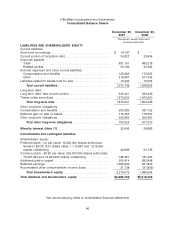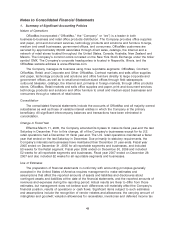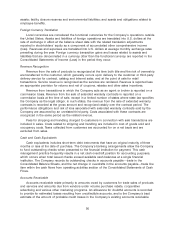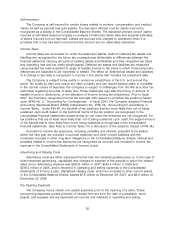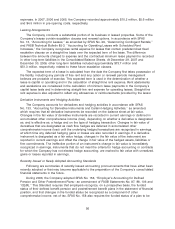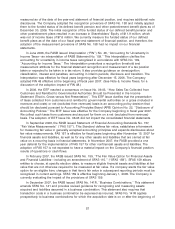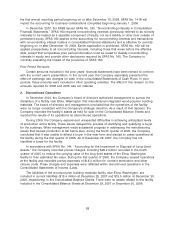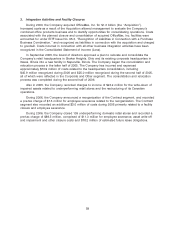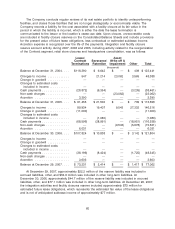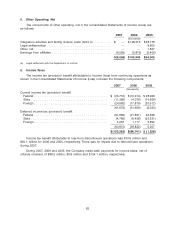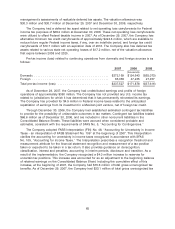OfficeMax 2007 Annual Report Download - page 59
Download and view the complete annual report
Please find page 59 of the 2007 OfficeMax annual report below. You can navigate through the pages in the report by either clicking on the pages listed below, or by using the keyword search tool below to find specific information within the annual report.Self-insurance
The Company is self-insured for certain losses related to workers’ compensation and medical
claims as well as general and auto liability. The expected ultimate cost for claims incurred is
recognized as a liability in the Consolidated Balance Sheets. The expected ultimate cost of claims
incurred is estimated based principally on analysis of historical claims data and actuarial estimates
of claims incurred but not reported. Losses are accrued and charged to operations when it is
probable that a loss has been incurred and the amount can be reasonably estimated.
Income Taxes
Income taxes are accounted for under the asset and liability method. Deferred tax assets and
liabilities are recognized for the future tax consequences attributable to differences between the
financial statement carrying amounts of existing assets and liabilities and their respective tax basis
and operating loss and tax credit carryforwards. Deferred tax assets and liabilities are measured
using enacted tax rates expected to apply to taxable income in the years in which those temporary
differences are expected to be recovered or settled. The effect on deferred tax assets and liabilities
of a change in tax rates is recognized in income in the period that includes the enactment date.
The Company is subject to tax audits in numerous jurisdictions in the U.S. and around the
world. Tax audits by their very nature are often complex and can require several years to complete.
In the normal course of business, the Company is subject to challenges from the IRS and other tax
authorities regarding amounts of taxes due. These challenges may alter the timing or amount of
taxable income or deductions, or the allocation of income among tax jurisdictions. Prior to fiscal
2007, the Company recognized income tax accruals with respect to uncertain tax positions based
upon SFAS No. 5, ‘‘Accounting for Contingencies.’’ In fiscal 2007, the Company adopted Financial
Accounting Standards Board (FASB) Interpretation No. (FIN) 48, ‘‘Accounting for Uncertainty in
Income Taxes.’’ Under FIN 48, the benefits of tax positions that are more likely than not of being
sustained upon audit based on the technical merits of the tax position are recognized in the
consolidated financial statements; positions that do not meet this threshold are not recognized. For
tax positions that are at least more likely than not of being sustained upon audit, the largest amount
of the benefit that is more likely than not of being sustained is recognized in the consolidated
financial statements. (See Note 6, Income Taxes, for a discussion of the adoption impact of FIN 48.)
Accruals for income tax exposures, including penalties and interest, expected to be settled
within the next year are included in accrued expenses and other current liabilities with the
remainder included in other long-term obligations in the Consolidated Balance Sheets. Interest and
penalties related to income tax exposures are recognized as incurred and included in income tax
expense in the Consolidated Statements of Income (Loss).
Advertising and Catalog Costs
Advertising costs are either expensed the first time the advertising takes place or, in the case of
direct-response advertising, capitalized and charged to expense in the periods in which the related
sales occur. Advertising expense was $242.6 million in 2007, $240.4 million in 2006 and
$276.2 million in 2005, and is recorded in operating and selling expenses in the Consolidated
Statements of Income (Loss). Capitalized catalog costs, which are included in other current assets
in the Consolidated Balance Sheets, totaled $7.6 million at December 29, 2007, and $9.3 million at
December 30, 2006.
Pre-Opening Expenses
The Company incurs certain non-capital expenses prior to the opening of a store. These
pre-opening expenses consist primarily of straight-line rent from the date of possession, store
payroll, and supplies and are expensed as incurred and reflected in operating and selling
55



